
VII. Other Specific Recommendations:
We have focused in this submission on the key issues of the debt and the deficit, on the dominant role that high interest rates have played in creating the problem, and on the necessity of bringing down interest rates as the key part of the solution. But we would also like to briefly run over a number of other specific concerns and recommendations we have regarding other aspects of this year's budgetary process.
Balance Between Spending Cuts and Tax Increases: As discussed in detail above, the key factor underlying the emerging debt crisis is monetarist interest rate policy. If we continue to accept the constraints of that policy as given, then no feasible spending cuts could possibly address the underlying problem. Similarly, no feasible tax increases could raise enough net revenue (after considering their contractionary impact on the macro-economy) to offset the continued drain of high interest rates. Moreover, relative to the declining quality of our public programs, the incidence of taxation in Canada is not too low--our apparent revenue problem derives from deliberate macroeconomic stagnation, not from under-taxation. So whether or not we cut program spending or increase taxes is a false, diversionary debate--neither can solve the root debt problem implied by Minister Martin's deficit arithmetic.
We do express our cautious support for the principle of closing tax loopholes that currently undermine revenue collections. We support in principle the position that the tax-free status of RRSP funds be capped at a reasonable level (at $1 million at the highest), and that the maximum allowable annual contributions be reduced. The RRSP benefit should be restructured into a tax credit, rather than a deduction. We also support efforts to crack down on income tax evasion--which most studies suggest is a much greater drain on public resources than the alleged problems of welfare and UI fraud which have captured so much attention in Minister Axworthy's social security review discussions.
Establish Formal Job-Creation Targets: We enthusiastically endorse the suggestion of the Canadian Labour Congress that the federal budget process include the establishment of formal job creation targets for upcoming years. The government has traditionally accepted the challenge of trying to meet specific deficit or monetary targets, but shrugs off responsibility for the most important economic indicator of all--the unemployment rate--to the so-called "free market". This is completely unsatisfactory. The government should enshrine its commitment to putting Canada back to work as its first economic priority, in the form of formal job creation targets. We urge the adoption of targets which would reduce the unemployment rate to 8.5% in fiscal 1995-96 and 7% (roughly equal to the prerecession unemployment rate) in the year after. These would be just the first steps in a longer process of reestablishing full employment in Canada, achieved through lower real interest rates and other measures.
Protecting Canada's Unemployment Insurance System: Many Canadians, ourselves included, fear that the primary driving force behind the government's review of social programs is not a genuine desire to improve these programs, but rather a fiscal imperative to simply cut costs. Thus we fear the changes that may be wrought in this federal budget to our social safety network, and to the Unemployment Insurance program in particular. We urge you to await the results of the reform process before making any further unilateral cuts to U.I.; otherwise, that entire process will have lost what little credibility it still retains. Given that the U.I. fund will earn a surplus this year measuring in the billions, there is no fiscal justification for further cuts. And we fear that U.I. cuts will lay the groundwork for the dramatic undermining of other Canadian social programs, including medicare and public pensions.
As we discussed in more detail in our brief to the Standing Committee on Human Resources Development, we strongly oppose the apparent conclusion of Minister Axworthy that major cuts to U.I. benefits will be required to reduce unemployment and fund expanded training services--whether those cuts take the form of further general cuts similar to those enacted in the 1994 budget, or a 2-tier U.I. system that targets so-called "frequent users". The key problem facing our social programs is a shortage of jobs in the economy, not the attitudes or behaviour of the unemployed. We will make every effort to mobilize our members into active opposition against this government if it continues in this socially destructive direction.
Curb Overtime: So much attention has been focused on the characteristics and alleged personal failings of Canada's unemployed people--the suppliers of labour services.(33) But what about the responsibility and failures of the demand side of the labour market--namely the behaviour of employers? One great contributor to the relatively jobless nature of the current recovery has been the great increase in average overtime hours worked in Canada.(34) We repeat our proposal, originally made to the Standing Committee on Human Resources Development, for the collection of separate UI premiums on overtime hours, which would not be subject to the yearly UI premium maximum. This would provide an incentive to both employers and workers to replace chronic overtime with the creation of new jobs. We also await with anticipation the upcoming recommendations of the special federal task force on working hours, co-chaired by Mr. Robert White, President of the Canadian Labour Congress, and we urge the Finance Minister (and the rest of cabinet) to take seriously its suggestions.
Taxation of Employment Benefits: We are concerned by suggestions that the federal government is considering treating employer contributions to group health and insurance plans as a taxable benefit. The CAW, along with other unions, has attempted for years to enhance the health care and other benefit programs provided by employers, and these programs have become both an important part of the overall compensation of our members and an important supplement to public health and insurance programs. Eliminating the tax-exempt status of these plans would have several negative effects. It would constitute a regressive shift in the burden of taxation (since the value of these premiums constitutes a much higher share of the total compensation of lower-paid workers). It would lead to an increase in the cost of the plans, since many workers and employers would withdraw if they had to pay tax on premiums, leaving only those who are most likely to need the program as subscribers, with a consequent negative impact on experience-rating. And it would also be ultimately reflected in increased demand on public health and insurance programs, since individuals would be more likely to have to fall back on these programs if their access to preventive programs (such as dental care, etc.) is curtailed. This proposal does not make fiscal or social sense; there are many other more expensive and less socially beneficial tax expenditures to be targeted. As our National President Basil Hargrove wrote to Finance Minister Martin earlier this year,(35)
"We are prepared to consider and support major tax reform initiatives, but we cannot support this proposal since it does not meet the tests of fairness and equity, will impair public health in the future and will have harmful effects for the general economy".
Conclusion:
In this submission we have accepted the Finance Minister's warnings that Canada faces a growing fiscal emergency. But we have disagreed fundamentally about the ultimate causes of that fiscal problem, and hence about what solutions will be required.
| According to the Minister's own deficit arithmetic, there is no possible way that the debt problem can be stabilized as a result of cutbacks alone--real interest rates have to come down. But the Minister's stated strategy for bringing down rates, by hoping that some symbolic cuts (and perhaps a "No" vote in the Quebec referendum) will somehow assuage the all-knowing financial markets, is shown to be an economically and empirically unfounded long shot. |
|---|
Our only hope for controlling this debt crisis is to take urgent, even dramatic action aimed at restructuring the institutions and behaviour of our financial system. It has been the deliberate use of this system since 1980 to maintain a permanent state of controlled economic recession that lies at the root of our fiscal difficulties. Rebuilding the types of regulations and institutional relationships that existed before 1980--lower real interest rates, more direct government involvement in rate-setting and in deficit financing, and perhaps some degree of control over speculative foreign exchange transactions--will be an essential first step to getting the debt under control, and putting Canada back to work.
This program will meet with fierce, even hysterical resistance from the financial analysts and speculators who have overseen and profited from the emergence of this casino economy. But they are not the ones who invest real labour, real skills, or real capital in real Canadian economic activity. Our economic policy has to put production before finance.
Simply complaining that this financial system is somehow beyond the levers of social control is a cop-out, and a highly political and ideological one at that, serving the vested interest of an increasingly well-defined elite of bond-holders and wealth-owners. As Canadian author John Ralston Saul recently put it,(36)
"The modern form of ideology is economic determinism. It is presented as if neither the presenter (a coalition of interest groups) nor the receiver (the public) have any active role to play because the global economy is going to arrive whether they like it or not. In this way a complete ideological policy can be advanced without any discussion of its implications or any admission that it is an ideology."
Challenging this ideology will be an essential prerequisite to any successful effort to come to grips with Canada's fiscal predicament.


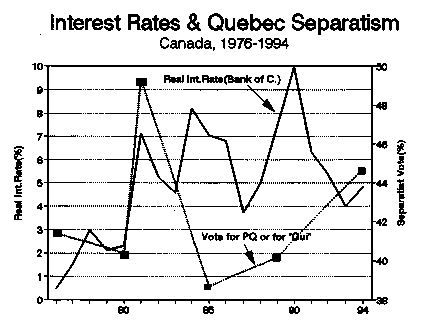
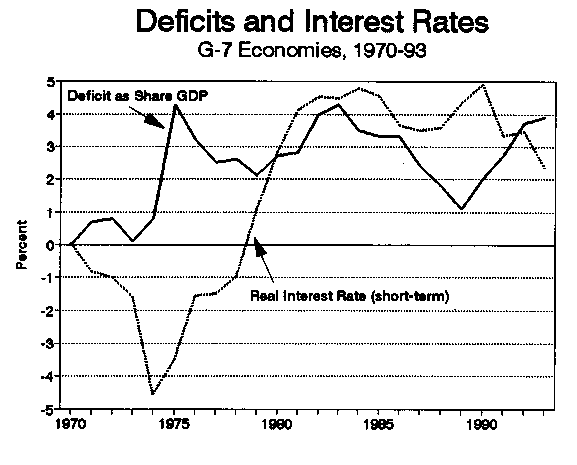
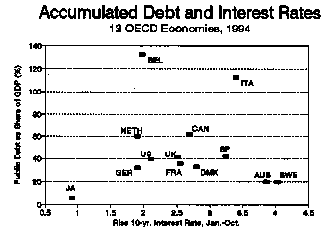
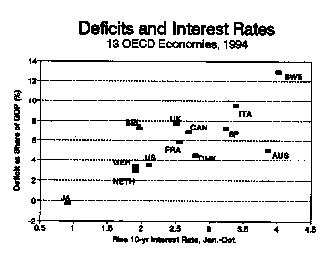
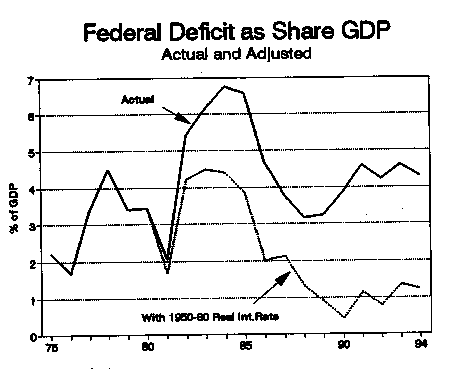
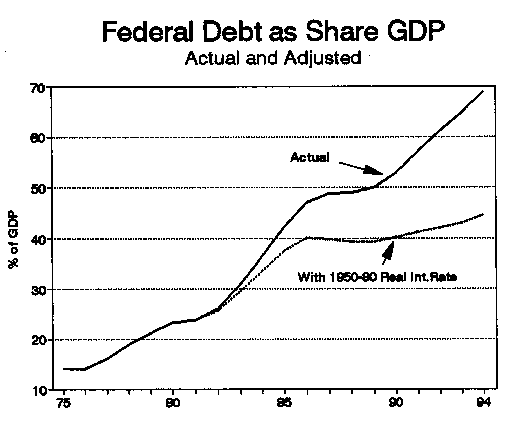

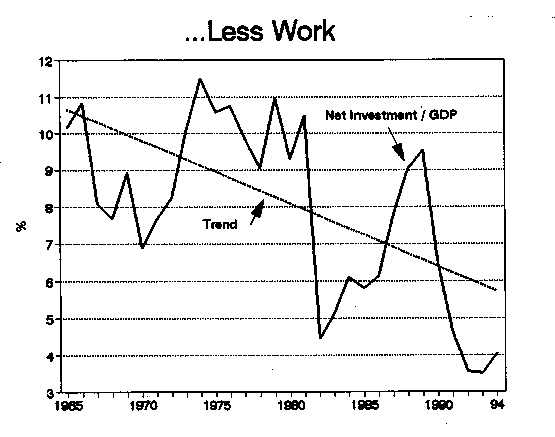
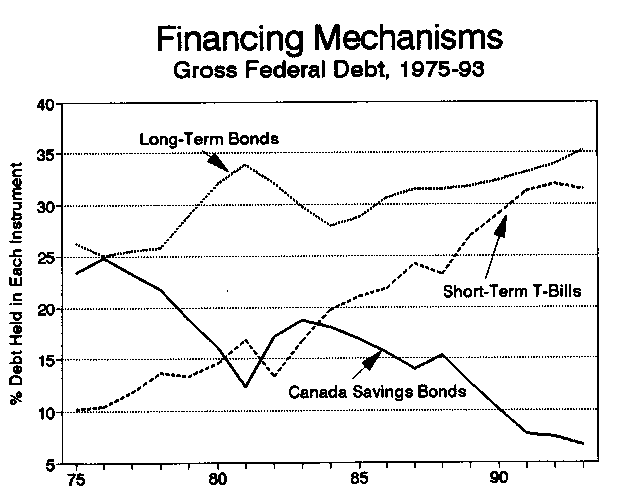

1. Despite these lay-offs, however, our union's membership continued to grow thanks to the organization of new units and mergers with other unions.
2. We are sceptical, for instance, that real investment spending in Canada iS constrained in any significant way by so-called "instability" arising from Canada's public debt. A much great factory restraining real investment is the lack of growing markets in which to sell finished goods and services, and a "slach-and-burn" approach to debt-reduction can only make that problem worse. We are also completely unconvinced that our high public debt causes higher interest rates: see Section III.
3. According to the OECD Economic Outlook, the four Scandinavian countries spent an arithmetic average of 0.9% of total government expenditures on interest payments in 1993, versus 6.4% for the OECD countries as a whole, and 10.3% for Canada. Two of the Scandinavian countries--Norway and Finland--actually have accumulated public surpluses,not public debts. These figures refer to expenditure and interest payments by all levels of government.
4. D stands for the stock of debt, i for the real interest rate, g for the growth rate of real GDP, and OB for the government's operating balance (revenues less current expenditures other than interest payments on the debt.)
5. Assuming an operating surplus in the current fiscal year of $5 billion.
6. See the Human Resources Development discussion paper, "Improving Social Security in Canada", p. 13.
7. Without dramatic action of the type that we propose below.
8. In this regard, we suspect that the consensus interest rate forecast reported by Minister Martin in "Creating a Healthy Fiscal Climate: The Economic and Fiscal Update" (p. 15)is highly optimistic. The forecast for 1995 allows for only a very slight increase (as little as 30 basis points) from current levels, and then it is assumed that rates decline again in 1996. If the U.S. Federal Reserve continues to tighten (as everyone expects), and if that action leads to even a slightly exaggerated reaction in Canadian markets (as occurred this year), then the rate next year (and probably the following year) will certainly be much higher than this forecast. Even Minister Martin's most pessimistic Scenario 3 contingency assumptions may not fully capture this risk.
9. Most recent data on labour incone is for August, and for housing starts in October; both reported in the Financial Post, November 9, 1994.
10. "In the early 1980s, the average interest rate on federal debt began to exceed GDP growth for the first time since the War and the gap has since widened. Now interest is compounding at a faster rate than the economy is growing." A New Framework for Economic Policy, p. 80-81.
11. The simple correlation coefficient between the two series is only .122. (The simple correlation measures the degree of correlation between two variables on a scale from 0 for no correlation to 1 for perfect positive correlation.)
12. The simple correlation coefficient between the separatist vote and the real interest rate over this entire period is a statistically insignificant .070.
13. After all, since global financial markets are highly integrated, the naive argument that government deficits drive up interest rates by "sucking up available" must operate on a global scale, with the exception of the risk premium effect.
14. Interest rate data from various issues of The Economist; public debt data(for all levels of government) from OECD Economic Outlook.
15. The simple correlation coefficient equals -.008.
16. Particularly when the two outlier observations (Japan and Sweden) are excluded.
17. The only countries which have even partially escaped higher interest rates are those larger economies--Japan, Germany, and to a lesser extent the U.S.--whose currencies are widely accepted in world markets as "reserve" currencies. Smaller countries' currencies inevitably bear the brunt of the speculative storms that follow interest rate changes, as asset-market speculators try to profit from the resulting reverberations in bond re-sale and forgeign exchange markets. The fantasies of John Crow notwithstanding, there is no hope of the Canadian dollar ever becoming the equivalent to the mark or the yen in the eyes of global currency speculators.
18. Although as shown above, the rate increase in Canada was considerably lower than that of several comparable economies, including Australia, Italy, and Denmark.
19. Federal interest payments on a national accounts basis, divided by the net federal debt, less the increase in the implicit GDP deflator. Data from Canadian Economic Observer, Historical Statistics, and Statistics Canada Catatlogue 68-508.
20. Again on a national accounts basis.
21. In fact, were the indirect fiscal effects of lower interest rates taken into consideration, the federal government would almost certainly be running a budget surplus.
22. As part of this virtual propaganda campaign, the business community and conservative commentators have so closely identified Canada's fiscal problems with social spending, that the words "deficit" and "social program" are becoming virtually synonymous. The Globe and Mail's editors write (on September 22, 1994) that "To move boldly...the government will have to draw a direct link between ends (a lower deficit) and means (a recast social system)." The C.D. Howe Institute titled its recent attack on the deficit The Courage to Act: Fixing Canada's Budget and Social Policy Deficits. The more rightly should have titled it Canada's Budget and Interest Payment Deficits, given the much larger drain on public finances associated with high interest rates.
23. Quoted by Bruce Livesey, "A frank look at Frank", The Financial Post Magazine, July 1994.
24. Data for both graphs from Canadian Economic Observer, Historical Statistics.
25. Without corresponding actions elsewhere in the financial system, this measure would only redirect the pressure resulting from asset market speculation by big investors, to the exchange rate in particular. But this would still be better than leaving the interest rate (which affects more directly the entire path of the economy) totally vulnerable to speculative determination on a week-to-week basis.
26. Data from Statistics Canada Catalogue 68-508.
27. This in turn is the result of the deliberate reliance by the Bank of Canada on "market-determined" monetary policy; see Kevin Fettig, "The Government of Canada Treasury Bill Market and its Role in Monetary Policy", Bank of Canada Review, Spring, 1994.
28. As during the speculative real estate boom of the late 1980s, for example.
29. Similar waiting periods are place (but only rarely enforced) on accounts with private banks, to protect the bank against sudden mass withdrawals during a speculative attack. The same principle would apply here.
30. If you are investing in an actual worksite with actual employees, rather than in paper assets, you are more concerned with the saleability of your output than with speculative asset market changes.
31. See A New Framework for Economic Policy, p. 72-73.
32 In this regard, the discussion paper's novel assertion ("A New Framework for Economic Policy", p. 81) that global real interest rates are high because of the heavy demand for capital from developing countries is laughable. The net "demand" for new capital by developing countries has shrunk dramatically from the 1970s, thanks mostly to monetary austerity and the slow-growth policies of international institutions. And the total call on capital resources by these countries is a fraction of the capital that was demanded by the now-industrialized countries during the quarter-century that followed World War II, yet real interst rates remained very low during that time. Indeed, if the interest rate is determined by supply and demand, it should fall over time as capital is accumulated and the aggregate capital-labour ratio rises; exactly the opposite occurred. Monetary economists trained at the University of Chicago and similar institutions will be unfamiliar with these alternative "structural" theories of how the financial system works; a good initial source is Colin Rogers, "Money, Interest and Capital", (Cambridge: Cambridge University Press, 1989), and references therein.
33. "A New Framework for Economic Policy" repeats much of this same off-topic analysis as does Minister Axworthy's discussion document: namely that unemployment does not result from a shortage of jobs, but rather from a lack of "confidence to embrace change" by Canadians (p. 47), the alleged "disincentive effects" of social security programs (p. 21), and an insufficient "commitment to building human capital" (p. 41).
34. For example, unpublished data from Statistics Canada suggests average overtime for hourly manufacturing workers in Canada has grown to almost 2.5 hours per week during the first 8 months of 1994.
35. Letter dated February 15, 1994.
36. "The Doubter's Companion: A Dictionary of Aggressive Common Sense" (Toronto: Viking, 1994), p. 144.

 Click here to return to the main
CAW Digital Collections page
Click here to return to the main
CAW Digital Collections page